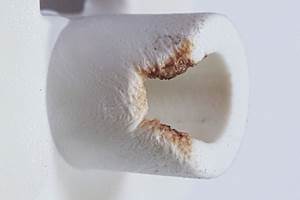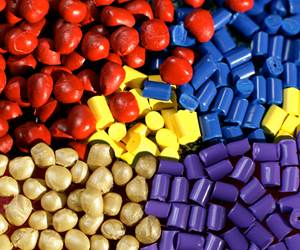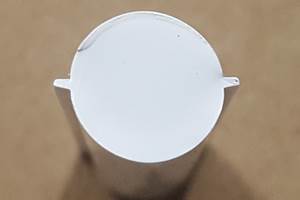How to Decrease the Extrudate Temperature in Single-Screw Extruders
In many cases, decreasing the discharge temperature will improve product quality and perhaps even boost rate. Here are ways to do it.
Many plasticating, smooth-bore, single-screw extrusion processes benefit from decreasing the extrudate or discharge temperature. These processes include foam sheet, pipe and profile extrusion, and blown film.
For example, foam sheet will typically have a higher quality when the extrudate temperature is decreased. This is because the foam will be less likely to collapse at the lower discharge temperature, maintaining a low foam density and high surface aesthetics. For pipe and profile extrusion, a lower extrudate temperature will provide improved cross sections by reducing resin sag or the distortion of the profile by reducing the resin movement due to gravity. Blown film processes become more stable with a lower extrudate temperature, proving less variation in film thickness in the machine direction. Moreover, all these processes could have a rate increase if the extrudate temperature can be reduced.
There are several short-term and a few long-term solutions to this technical problem. The simplest short-term solution is to decrease the barrel temperatures that cover the metering section and mixer. As a guide, every reduction of 10°C on the metering section barrel zones will decrease the extrudate temperature by 2-3°C. This guide works well for 3.5-inch diameter extruders and smaller that do not have worn screws and barrels.
For larger diameter extruders and extruders that are worn, the decrease in temperature will be less than 2°C. The barrel temperature zones that cover the solids conveying section and melting section should not be decreased. If these zone temperatures are decreased, poor solids conveying and possibly flow surging can occur and the melting process may not be complete.
Reducing the discharge pressure will allow an increase in the specific rate and a decrease in the discharge temperature. The specific rate is simply the rate divided by the screw speed. The best short-term solution to decreasing the discharge pressure is to replace fine mesh screens with screens that have a coarse mesh such as to reduce the restriction to the flow. For example, a 6-inch diameter extruder running a 1 dg/min (2.16 kg, 190°C) melt index (MI) resin at 1,600 lbs/hr. as a function of discharge pressure is shown in Figure 1. For a fine mesh screen in the filter pack or for a fouled screen, the discharge pressure can be relatively high.
The best option for decreasing the discharge temperature is installing a new screw with a deeper metering channel.
In the case of Figure 1, the maximum discharge pressure was 3,500 psi with a discharge temperature of nearly 237°C. If a courser screen could be used, the discharge pressure might be able to be decreased to 2,000 psi and a discharge temperature of 234°C. This operation decreased the discharge temperature by about 2.3°C. The plant, however, has decreased the level of filtering which could decrease the value of the product. The reduction in filtering ability may not be worth the small reduction in discharge temperature.
The Gear Pump Option
Two additional long-term options are possible. The first and highest cost option is purchasing and installing a gear pump. The pump would be positioned between the extruder and the filter pack. Gear pumps typically operate with an inlet or suction pressure of about 700 to 1,200 psi, and it would discharge at a much higher pressure at a metered rate. Thus, the discharge pressure of the extruder would be the inlet pressure to the pump.
In Figure 1, the discharge pressure for the extruder and no gear pump could be as high as 3,500 psi and a discharge temperature of 237°C. If a gear pump is installed, the discharge pressure from the extruder would be decreased to 700 psi and the discharge temperature to 233°C. Here the temperature decreased 4°C. The temperature decreased because the specific rate increased from 25.8 to 28.6 lbs/(hr. rpm).

Figure 1 – Discharge temperature and specific rate for a 6" diameter screw running a 1 MI LLDPE resin at 1,600 lbs/hr. as a function of discharge pressure.
Moreover, the pump will provide a very consistent flow rate that could enable the operation of the process near the minimum thickness of the product specification, minimizing the amount of resin consumed. A temperature reduction of 4°C, however, may not justify the high cost and operational complexity of a gear pump.
The best option for decreasing the discharge temperature is installing a new screw with a deeper metering channel. In all but some extremely rare cases, a screw with a deeper metering channel will operate with a higher specific rate and a lower discharge temperature. All other sections of the screw would be designed such that they are compatible with the metering channel depth. The metering channel depth is used because it controls specific rate and discharge temperature.
For example, Figure 2 shows the discharge temperature and specific rate for the same 1 MI LLDPE resin running at 1,600 lbs/hr. for a 6-inch diameter screw. The discharge pressure was held constant at 3,500 psi. The discharge temperature was about 245°C for a metering channel that was 0.380 inch deep. At this shallow depth, the specific rate was 23.5 lbs/(hr. rpm) and the screw had to rotate at 68 rpm to get the 1,600 lbs/hr. When the channel depth was increased to 0.480 inch, the discharge temperature decreased to about 227°C, and the specific rate increased to 29.1 lbs/(hr. rpm). Thus, the discharge temperature decreased by 18°C, and the specific rate increased by 24%. Adjusting the metering channel depth is the best way to tune the temperature of the extrudate to a target value.

Figure 2 – Discharge temperature and specific rate for a 6" diameter screw running a 1 MI LLDPE resin at 1,600 lbs/hr. as a function of metering channel depth.
At the same rate, a deeper screw will operate at a lower screw speed. At the slower screw speed, the torque requirement for the screw will increase. Motor current is directly proportional to torque. Most times, adequate torque is available, but on occasion a deeper screw could not be used because the shallow screw was operating near the maximum available torque. Torque and motor power were discussed in the May 2024 issue of this magazine.
At the same rate, a deeper screw will operate at a lower screw speed.
Screw designers know how to build screws that discharge at the desired rate, pressure and temperature. The channel depth, pressure and temperature relationship for a resin is easily understood using numerical simulations. Figures 1 and 2 were constructed via numerical simulation. Once these types of figures are constructed, the depth of the metering channel is easy to determine.
In many cases, decreasing the discharge temperature will improve product quality and possibly enable a rate increase, especially by installing a screw that has a slightly deeper metering channel. If a line is sold out, a rate increase can provide additional profit to the bottom line of the company.
About the Author: Mark A. Spalding is a fellow in Packaging & Specialty Plastics and Hydrocarbons R&D at Dow Inc. in Midland, Michigan. During his 39 years at Dow, he has focused on development, design and troubleshooting of polymer processes, especially in single-screw extrusion. He co-authored with Gregory Campbell. Contact: 989-636-9849; maspalding@dow.com; .
Related Content
Back to Basics on Mold Venting (Part 1)
Here’s what you need to know to improve the quality of your parts and to protect your molds.
Read MoreFundamentals of Polyethylene – Part 6: PE Performance
Don’t assume you know everything there is to know about PE because it’s been around so long. Here is yet another example of how the performance of PE is influenced by molecular weight and density.
Read MoreThree Key Decisions for an Optimal Ejection System
When determining the best ejection option for a tool, molders must consider the ejector’s surface area, location and style.
Read MoreWhere and How to Vent Injection Molds: Part 3
Questioning several “rules of thumb” about venting injection molds.
Read MoreRead Next
For PLASTICS' CEO Seaholm, NPE to Shine Light on Sustainability Successes
With advocacy, communication and sustainability as three main pillars, Seaholm leads a trade association to NPE that ‘is more active today than we have ever been.’
Read MoreMaking the Circular Economy a Reality
Driven by brand owner demands and new worldwide legislation, the entire supply chain is working toward the shift to circularity, with some evidence the circular economy has already begun.
Read MoreSee Recyclers Close the Loop on Trade Show Production Scrap at NPE2024
A collaboration between show organizer PLASTICS, recycler CPR and size reduction experts WEIMA and Conair recovered and recycled all production scrap at NPE2024.
Read More











